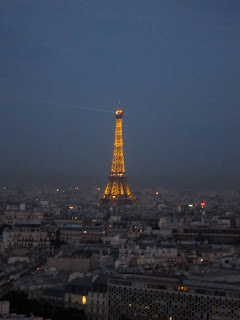
I would hardly call myself a lonely person, and I love doing things on my own, but there is something lonely about seeing these beautiful sights by myself, and not being able to share them with Steve, or a friend, in the moment.
The daytime is easier; I am quite happy wandering around in my own world, reading my book over a meal or an espresso. But when nighttime comes, I feel a bit more uncomfortable. There is something about going out to eat dinner by myself that feels awkward; harder to just read my book in my own world. And I am not adventurous enough to go to a wine bar by myself at night, because (and maybe I flatter myself here) I don't want to get chatted up by random people, especially not in French. Is that lame of me?
I know I should just enjoy it, though, because over the next 4 months Steve and I will, I'm sure, drive each other crazy, and we will wind up begging for a few days to ourselves.
Anyway, I spent the morning at my favorite museum in Paris, the Musee Rodin. It was pouring rain outside when I went, which on the upside was very atmospheric but on the downside, it may have made the museum busier.
And the humidity, my god, the air was so thick I could barely breathe. I don't want to sound like a spoiled American here, but a little air conditioning goes a long way. It doesn't even have to be cold, just get some airflow going. Or just a fan, how about that? Just a fan on rotate so that the air actually moves in the room. Just a suggestion.
After that I went to a conveyor-belt sushi restaurant. Yep, you read me right. Conveyor-belt sushi. I had read about it in my Zagat guide, and the place was absolutely packed. The way it works is this: You sit down at a seat which faces a moving conveyor belt. The chefs prepare various dishes and then place them, covered with clear plastic covers, on this conveyor belt, and you just grab whatever looks good to you. The plates are color-coded, with each color being a different price. When you are ready to leave, the waiters simply add up how many of each color you had and voila, your bill!
Now since it was warm out and since it is, after all, conveyor belt sushi, I didn't actually eat anything raw. I did, however, have a lovely crunchy cabbage salad, a veggie roll, and a cooked salmon and tuna roll. It was just what I was in the mood for, since I just couldn't face another heavy meal.
Today I also went to the Musee du Vin. This was, I have to say, the oddest museum I have ever been to. The audio tour was so strange I wondered if it was a joke. The museum is basically a restaurant with some tunnels leading off to the side. These tunnels contain a lot of wine-making and grape-growing paraphernalia from the 18th and 19th centuries.
The audio tour felt to me as though it had just been recorded that morning by some girl with a microphone in her living room. I could hear her turning pages, taking deep breaths, and at one point sighing, as if she was bored out of her mind.
Every so often, something she said would be punctuated by loud classical music, the same bars each time. The music would suddenly start playing, and then would just as suddenly cut out. At first I thought it signified a transition to the next display of the tour, but that turned out not to be the case, as when the music stopped, she started talking about items displayed in the cases back where I had previously been standing.
And it was just so poorly organized that I had no idea what I was supposed to be looking at when. The tour gave you no real clue. She would say: "Items 2, 12, 85 and 16 were used for decanting in the 18th century", and I would be struggling to locate these items which were, of course, nowhere near each other, and were sometimes in different cases, so I was whipping around trying to locate things, giving myself whiplash.
As soon as I had located at least one of the items she referred to, she had already rattled off 16 other items I should be looking at, and then the music would play.
Then there were wax-people displays set up, one of which showed Napoleon and two other dudes, standing amongst wine barrels. The audio for this was: "Here is Napoleon. He liked wine." And the music played.
I just didn't understand what was happening.
By far the best moment came when I reached the corkscrew display, and the audio mentioned that the cork became the preferred preservation method, replacing hemp, muslin, paper and toe.
I'm sorry, did she say toe? Now I'm sure that word is probably spelled differently and means something else, but it was too late; I was off.
I couldn't stop imagining all of these wine bottles corked with the toes of vintners and their families. How relieved they must have been to see the cork become fashionable. Now the mystery of the toe-less winemakers of the 18th century has been solved.



For the record and courtesy of Merriam-Webster:
ReplyDeletetow, n.
1 : short or broken fiber (as of flax, hemp, or synthetic material) that is used especially for yarn, twine, or stuffing
2 a : yarn or cloth made of tow b : a loose essentially untwisted strand of synthetic fibers
(I suspected that spelling because of the term "tow-headed", which is clearly nothing to do with the verb.)
But "toe" is still funnier.
Well, that explains it. At least I can rest easy knowing those winemakers got to keep their toes!!
ReplyDelete